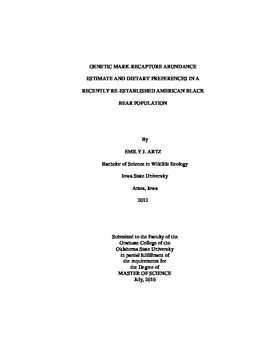| dc.contributor.advisor | Fairbanks, Sue | |
| dc.contributor.author | Artz, Emily Jo | |
| dc.date.accessioned | 2017-02-22T22:13:37Z | |
| dc.date.available | 2017-02-22T22:13:37Z | |
| dc.date.issued | 2016-07-01 | |
| dc.identifier.uri | https://hdl.handle.net/11244/49035 | |
| dc.description.abstract | American black bears (Ursus americanus) are recolonizing parts of eastern Oklahoma that they have not occupied since the late 1800s. The Ozark region black bears are adapting their diets and foraging behaviors to include anthropogenic foods, causing property damage and human-bear conflict. To effectively manage this likely growing population, a baseline abundance estimate and a better understanding of the Ozark American black bear�s foraging preferences is necessary.Live trapping in 2011�2015 marked 49 individuals. In 2014 I established a grid of 46 barbed wire hair snares to collect DNA for a genetic mark-recapture abundance estimate using microsatellite analysis. Over 5750 sampling opportunities in 2014 and 2015, we collected 369 hair samples, 85 of which amplified at ? 7 loci. Using a full-likelihood model, we estimated a population of 100.91 individuals � 23.45 (95% CI). The sex ratio of live captured bears was 2.4 males : 1 female, and the median age of both males and females was 3 years. The young, male-biased demography suggests that the Ozark population contains many recent immigrants dispersing from the larger Arkansas population. To examine diet preferences, we developed a novel experimental approach to examine black bears� preference for natural versus anthropogenic foods using �giving up density� methods. We designed experimental feeders which were tested on a captive female grizzly bear at the Tulsa Zoo, Tulsa, Oklahoma. Feeders were filled with either natural foods (acorns or blueberries) or anthropogenic foods (corn) and deployed them as pairs suspended from tree branches. The bears manipulate the feeders to obtain a food reward. We standardized the size of the food reward by partitioning food in edible gelatin capsules. Each food capsule contained a standard number of calories regardless of food type. We calculated which food the bears preferred when both were equally available, based on how much of each food type remained after a bear interaction. We deployed pairs of feeders in six locations and monitored them with trail cameras. Over 3 months, bears interacted more often with feeders containing corn, removed more corn, and spent more time manipulating feeders for corn. This suggested that bears were willing to spend more effort to obtain corn than native foods when both are equally available. | |
| dc.format | application/pdf | |
| dc.language | en_US | |
| dc.rights | Copyright is held by the author who has granted the Oklahoma State University Library the non-exclusive right to share this material in its institutional repository. Contact Digital Library Services at lib-dls@okstate.edu or 405-744-9161 for the permission policy on the use, reproduction or distribution of this material. | |
| dc.title | Genetic Mark-recapture Abundance Estimate and Dietary Preferences in a Recently Re-established American Black Bear Population | |
| dc.contributor.committeeMember | Leslie Jr, David | |
| dc.contributor.committeeMember | Luttbeg, Barney | |
| osu.filename | Artz_okstate_0664M_14756.pdf | |
| osu.accesstype | Open Access | |
| dc.description.department | Natural Resources and Ecology Management | |
| dc.type.genre | Thesis | |
| dc.type.material | text | |
